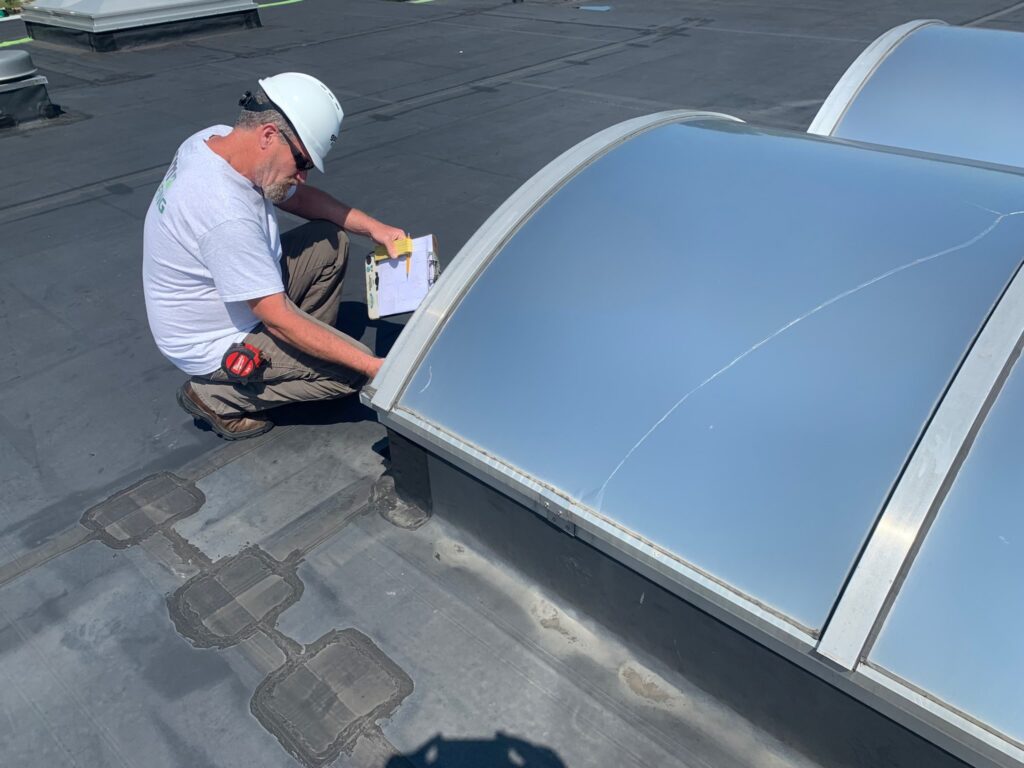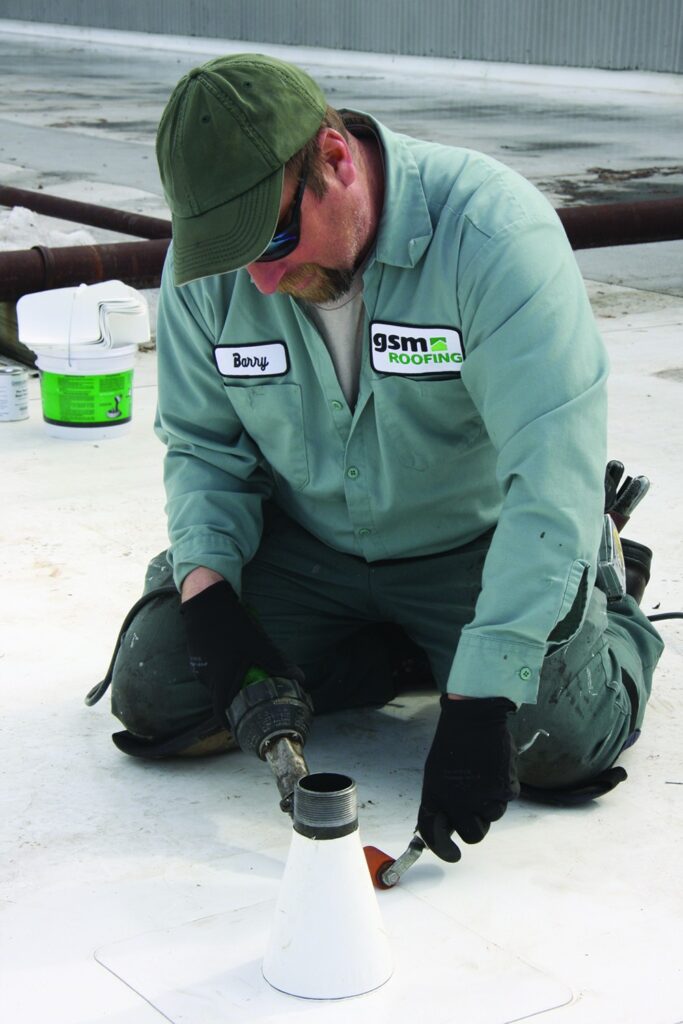Choosing the Right Roofing Contractor
A professional roofing contractor, like GSM Roofing, will be familiar with building codes, preventing potential issues with inspections or code violations. Plus, we’re highly experienced in roofing systems, allowing us to assess the condition of the roof, ensure proper waterproofing, and integrate the roof curb seamlessly.
We know you have a lot of contractors to choose from for your roofing work. We also know that having the right commercial roofing contractor will mean the difference between roof curb installation that protects your building and curb or flashing that could cause problems.
If the curb is installed incorrectly, it will result in leaks that can go undetected for long periods, causing damage, costly repairs, and voided warranties. So, choose an experienced roofing contractor – the one who will work during off-hours to keep downtime to a minimum and the one who knows how to keep your building dry.
Roof Curb FAQs
How much will a Roof Curb Installation Cost for My Building?
The cost of installing a roof curb on a commercial building varies depending on size, complexity, materials used, labor rates, customization needs, roof type, accessibility, compliance with building codes, additional features (like insulation), potential removal of existing structures, and permit fees. On average, prices can range from a few hundred to several thousand dollars. GSM can assess your specific building needs and provide you with a more detailed estimate.
Are there Specific Building Codes or Standards Governing Roof Curb Installations?
When GSM Roofing installs roof curbs, they must adhere to relevant building codes and standards, which include ensuring structural integrity, proper waterproofing, compliance with height and material requirements, maintaining ventilation and airflow (especially for HVAC equipment), adhering to fire safety standards, and ensuring accessibility for maintenance. These installations are guided by local building codes as well as national standards like those from the International Building Code (IBC) and the National Roofing Contractors Association (NRCA). It’s important for GSM Roofing to follow these guidelines to ensure safety and effectiveness.
How do you Determine the Appropriate Size and Specifications for a Roof Curb?
For GSM Roofing to determine the appropriate size and specifications for a roof curb, they should consider the equipment it will support (size and weight), the roof’s structure and load-bearing capacity, local weather conditions, insulation and energy code requirements, proper waterproofing and drainage, curb height for water pooling and code compliance, adequate ventilation for HVAC units, ease of access for maintenance, and adherence to local building codes. Additionally, following the equipment manufacturer’s specifications is crucial. These considerations ensure a safe, effective, and compliant roof curb installation by GSM Roofing.
Can you Install Curbs on all Types of Roofing Materials?
Yes, roof curbs can be installed on most types of roofing materials, but the method varies. Metal roofs require special flashing for waterproofing, while flat roofs like EPDM, TPO, or PVC need a watertight seal at the curb connection. Built-up roofs and asphalt shingles also support curbs but require careful sealing. For slate or tile roofs, specialized techniques are essential to avoid damage. The key in all cases is ensuring proper waterproofing and load distribution, and it’s important to consult with roofing professionals experienced with the specific roofing material.
Do you Provide Custom Design Services for Unique Rooftop Installations?
GSM Roofing will work with the HVAC contractor in order to design the appropriate system.
Does Your Team also Retrofit Existing Roof Curbs for New Equipment Installations?
Yes, GSM does retrofit existing roof curbs for new equipment installations. Retrofitting is often a cost-effective and efficient solution compared to installing a new curb, but it requires skilled professionals to ensure that the modified curb meets all necessary standards and specifications.
What is Your Team’s Process and Technology used for Cutting the Roof Deck and Installing the Wood Blocking?
The process of cutting the roof deck and installing wood blocking involves several steps, typically using a combination of manual and power tools. Here’s an overview of the process:
- Planning and Marking: First, the area where the roof deck will be cut is carefully marked. This is based on the dimensions of the roof curb or equipment that will be installed. Accurate measurements are crucial to ensure a proper fit.
- Safety Precautions: Before any cutting begins, appropriate safety measures are taken. This includes securing the work area, using personal protective equipment (like gloves, safety glasses, and hearing protection), and ensuring that the roof is safe to walk on.
- Cutting the Roof Deck: The cutting is typically done with a circular saw or a reciprocating saw, adjusted to the correct depth to avoid damaging underlying structures. The cut is made following the previously marked lines.
- Removing Cut Material: The cut section of the roof deck is carefully removed. This might require additional tools like pry bars or hammers.
- Preparing for Wood Blocking: The area around the cut is prepared for the installation of wood blocking. This includes cleaning any debris and ensuring a level surface.
- Installing Wood Blocking: Wood blocking, usually treated lumber, is cut to fit snugly around the perimeter of the opening. It’s secured in place with fasteners, providing a solid frame for the roof curb.
- Installing the Roof Curb: Finally, the roof curb is installed onto the prepared base.
- Sealing and Waterproofing: Once the wood blocking is installed, it is sealed and waterproofed to prevent moisture ingress. This method changes based on the roof type.
- Inspection: After installation, an inspection ensures everything is secure and properly waterproofed.
This process requires skilled labor and an understanding of roofing systems to ensure the structural integrity of the roof is maintained and the installation is watertight. It’s advisable to have this work done by professional roofing contractors who are familiar with the specific type of roofing material and building codes.
Once the Curb is Set, how does Your Team Apply Flashing?
Our team would typically follow these steps to apply flashing:
- Prepare the Surface: Ensure the area around the roof curb is clean and dry. This may involve removing old flashing, sealants, or debris.
- Measure and Cut Flashing Material: Measure the flashing material to fit the dimensions of the roof curb. The flashing should extend several inches beyond the edge of the curb on all sides.
- Apply Base Flashing: Attach the base flashing to the lower edge of the roof curb. This is usually done with fasteners and/or a suitable roofing adhesive, ensuring a secure and waterproof seal.
- Seal Joints: Use a high-quality sealant to seal the joints where the flashing meets the curb. This is crucial for waterproofing.
- Apply Counter Flashing: If required, counter flashing is then installed. This piece overlaps the base flashing and is usually affixed to the vertical surface (like a wall or the side of the HVAC unit) to provide an additional layer of water protection.
- Seal and Secure: Ensure all edges of the flashing are sealed and secured. Check for any gaps or potential weak points where water might penetrate.
- Inspect and Test: Once installed, inspect the flashing thoroughly to ensure a proper fit and seal. It might also be tested with water to check for any leaks.
Note: The specific materials and methods used can vary based on the roof type, curb design, and local building codes. It’s always recommended to follow manufacturer guidelines and industry best practices. For the most effective and long-lasting results, employing a professional roofing team with experience in flashing installation is advisable.
Are there Maintenance Requirements for Roof Curbs, and how often Should They be Inspected?
Roof curbs require annual inspections, or more frequently in severe weather areas. Key maintenance aspects include checking the sealant and flashing for wear or gaps, inspecting the curb for structural damage (like rust or corrosion), clearing debris to ensure proper drainage, verifying that any mounted equipment remains secure, and assessing for weather-related damage after severe weather events. Regular maintenance and timely repairs are crucial to prolong the curb’s lifespan, and it’s beneficial to include these checks in your building’s overall maintenance routine. Consulting with roofing professionals for these tasks is recommended for thoroughness.
What is the Typical Lifespan of a Professionally Installed Roof Curb?
The typical lifespan can vary depending on several factors. But generally, a well-installed and properly maintained roof curb can last between 20 to 30 years. This lifespan is influenced by the materials used (metal curbs might have different lifespans than those made from other materials), the quality of installation, the environmental conditions (such as exposure to extreme weather or corrosive environments), and the level of maintenance it receives. Regular inspections and maintenance can help ensure the roof curb remains in good condition and extend its lifespan.
Do You Offer Warranties for Your Roof Curb Installations, and What do They Cover?
GSM Roofing gives a one-year warranty for all the curb installations that we complete. This warranty covers labor and material. During curb installation, we follow manufacturer guidelines so that the curb warranty aligns with the existing roof warranty.
Can You Share an Example of a Successful Roof Curb Installation You’ve Completed?
We have completed thousands of successful curb installations over the course of our over 75 years in business. Our teams are installing curbs weekly throughout the tri-state area. For more details on a particular successful curb installation, please reach out to us, and we would be happy to provide additional information.
Have more roof curb installation questions?
Feel free to get in touch with us at 800-532-7663. With 80 years of experience, GSM Roofing serves Pennsylvania, New Jersey, Delaware, and most of Maryland. We’ll work with your HVAC company for new construction or equipment replacement, submit a bid to a general contractor, or simply answer your questions regarding roof curbs.


